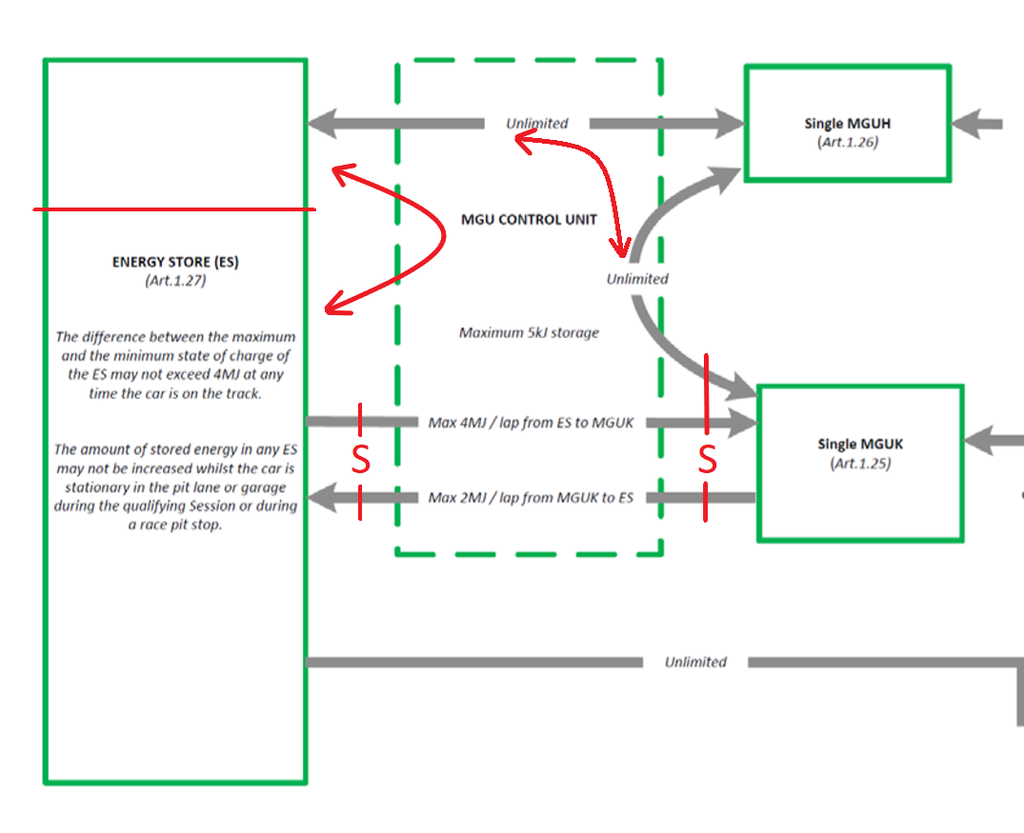henry wrote: ↑29 Jul 2018, 23:17
I’m not sure the energy needs to be stored kinetically. There may be enough energy storage in the CUs to make that unnecessary.
I had to think hard about that one. I get there with the engineering equivalent of a shaggy dog story, but as we know, shaggy dogs win races
There's a question mark of where the sensors are placed. As the CU's are unique, presumably the FIA comes to an arrangement with the engine manufacturer. Further uncertainty surrounds where the single sensor is placed in the permitted dual battery system (because there are 2 battery connections to monitor with 1 sensor)
As a thought exercise, consider this:
We know it is permissible to segment the Energy Store (battery pack). One scheme could be to allocate each MGU a segment of the ES. We know the relative demands on the battery, so the MGU-K would have a large segment (of the battery), while the MGU-H a small segment
The flow paths in and out the MGU-H (to/from ES and MGU-K) are unregulated. In that sense there seems no need to measure the per lap energy transfer in and out of the segment of the ES connected to the MGU-H
During normal (race) conditions the MGU-H transfers energy to the ES only in the final stage of acceleration (when the rain light flashes, and both MGU's are harvesting) otherwise energy is delivered to the MGU-K for extra power
On exiting a corner, when the turbo would otherwise be off-boost, the energy flow is reversed and the MGU-H is driven in motor mode (electric supercharger). This is an intrinsic part of how the hybrid power unit operates
So, the segment of the ES connected to the MGU-H can be said to be a transient (short-term) energy store. It receives and releases energy either side of the braking phase. Consequently, the energy storage of this segment can be made small
[During quali, the MGU-K doesn't harvest at the end of the straight, but MGU-H may switch to charging the ES during the same phase, or the MGU-K could charge both segments of the ES during the braking phase]
[Shaggy dog alert] One possible way around the problem of separating the energy flows for measurement purposes is to use a known value for some of the less dominant paths. For example, the "other ancillaries" path could have a rev-dependant energy consumption figure that can be reasonably estimated by calculation (this can be checked by inspection)
If the small segment of the ES can be shown to have a negligible effect on the total effective capacity of the ES, then it would seem reasonable to use a calculated figure for this path too. As there is no need to measure this path, you would place your 1 ES sensor on the other segment of the ES (the one connected to MGU-K, over which nearly all the energy flows)
During use the energy in and out of the MGU-H is so small and so time limited it would have little effect on the permitted 4MJ effective capacity. However, it would seem reasonable to subtract the calculated effective capacity of the small segment from the total permissible amount and apply that new figure as a new, lower limit, to the large segment [For sake of comprehension, let say the small segment is calculated as 0.1MJ, so we need to apply a measurement limit of 3.9MJ to the large segment]
I believe that now gives the required separation of CU electronics and energy paths (one of which is now unmonitored) to enable your electronic transfer of energy

